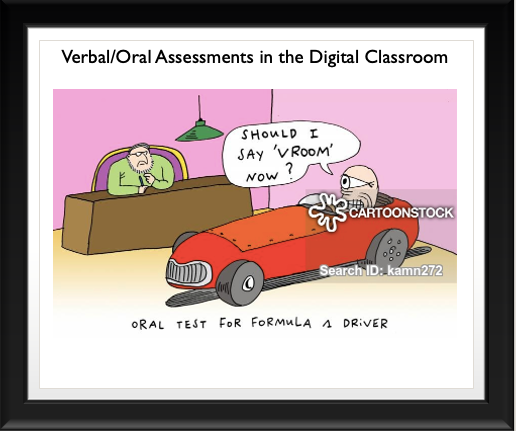It was great to see so many folks attend the Digital Toolshed to discuss: What Makes a Good Oral Assessment?
As a Trades Faculty many of our instructors have implemented some form or another of an Oral Assessment or Examination since Covid-19 disrupted our traditional practices back in March, 2020. It’s now fair to say that we have enough collective experience amongst us to talk about this topic, in-depth, for way longer than an hour.
As a result, we are pleased to have put together a resource to share with other instructors.
Let’s start by answering the following question:
What’s the Value an Oral Assessment/Exam?
The group discussed this topic very passionately and came up with four key reasons why this method of assessment is valuable to the learner, whether it be in a digital or traditional classroom
- This methods provides the learner an opportunity to explain a concept, which demonstrates a higher level of understanding than the level of memorization that is typically associated with multiple-choice exams
- The oral assessment enhances students’ levels of oral literacy
- Oral communications skills are essential to students’ success in industry
- Students learn to express their understanding through spoken language, which goes beyond memorization
So, what does an oral assessment consist of?
- The assessment should consist of 2 or 3 higher level questions. Ideally these will follow one theme, and progress to deeper levels of understanding and complexity with each question
- The student meets with the instructor one-on-one via zoom
- Set time limits: 3 questions = 15 minutes
Okay, now you know what an oral assessment consists of and have some very good reasons why this a valuable tool for you to use.
But not so fast, we have a few questions for you to consider first?
- Is the oral assessment being used as a formative, or summative assessment tool?
- What resource/s does the learner have to review following the assessment?
- How is feedback being given? Verbal/written feedback, Rubric, Grade, Rating Scale?
- How does the feedback given align with the intended Learning Outcome?
- Is the learner given an opportunity to review and revise their submission?
Now that you are ready to get started, let’s us share our best practices
#1 Best Practice: Prepare your students for this new method of assessment
The group decided unanimously that the instructor must prepare students throughout the semester with a variety of activities that get them ready to be successful in the oral assessment. These include the following suggestions:
- Build in similar activities throughout the semester to help students prepare for the oral assessment
- Encourage students to use the chat area in Zoom to problem solve and provide solutions throughout regular Zoom sessions. This activity models a collaborative approach towards developing a critical thinking frame of mind
- Set up break out groups where students describe and explain concepts to each other
- Have students present projects, such as final capstones, to each other prior to the assessment. Provide time between student presentations and the final oral assessment, so that students can make changes based on peer feedback
- Provide students with the oral assignment, a list of possible questions, and the marking rubric prior to the assessment
- Embed self-reflection/self-evaluation into your weekly assignments
This all sounds good, right? Is it too good to be true? No. But we do want to share one or two implementation challenges to look out for:
Implementation Challenges:
- It’s time consuming
- Managing Student anxiety (see section on preparing students)
- Assessment: Subjectivity versus objectivity (Rubrics are key)
We hope that this faculty built resource will be helpful to you in developing and implementing an Oral Assessment in the future. As we, as a faculty progress in our experience and understanding of such approaches, we will continue to update this page.
If you have thoughts and suggestions regarding oral assessments, we’d love to hear from you. Please enter your thoughts and feedback into the comment box below.
If you have problems entering a comment, make sure the url that you are using includes an s after the https:

Leave a Reply